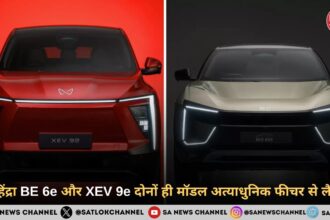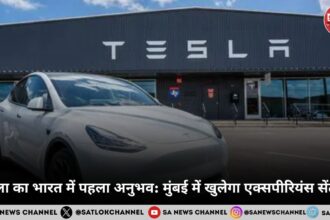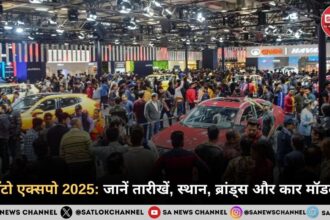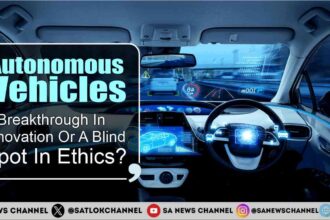What once seemed possible only in science fiction has now become a reality. A Tesla electric vehicle has successfully driven itself from the company’s Gigafactory to a customer’s home with zero human intervention. Utilizing Tesla’s Full Self-Driving (FSD) Beta system, this achievement marks a pivotal step in the evolution of self-driving technology.
- Highlights on Tesla Car
- Full Report
- How the Self-Driving Delivery Worked
- Reactions from Elon Musk and the Owner
- Tesla’s Long Road to Full Autonomy
- Safety Measures and Government Oversight
- Spiritual Insight: A SatGyan Perspective
- Global Reactions
- How Tesla Stands Against Competitors
- Is the Robo-Taxi Era Next?
- Conclusion
- FAQs
Highlights on Tesla Car
- First-ever customer delivery completed autonomously by a Tesla vehicle
- Journey included factory departure, freeway travel, urban navigation, and residential arrival
- Zero manual or remote control involved
- Tesla engineers supervised the trip in real-time
- The event sparks global discussions on safety and future regulations
Full Report
On June 27, 2025, Tesla took a leap into the future of mobility when a new Model 3, directly from its Gigafactory in Austin, Texas, autonomously navigated more than 37 miles to its owner’s residence—completely unassisted by human control.
This revolutionary journey was powered by Tesla’s Full Self-Driving Version 12.3 software, an advanced AI system with neural network processing, continuous learning capabilities, and 360-degree environmental sensing, enabling it to perform complex driving tasks with extraordinary precision.
How the Self-Driving Delivery Worked
After completing final inspections on the assembly line, the vehicle was activated within the Gigafactory. It exited onto Tesla’s private track, merged safely onto Interstate 35, and followed its designated route—all while under passive remote monitoring.
With a suite of eight cameras, radar systems, ultrasonic sensors, and a high-speed onboard AI processor, the vehicle followed traffic laws, performed smooth lane changes, respected traffic lights, and yielded to pedestrians.
Upon reaching the gated community of the buyer, it slowed, identified the address, and parked perfectly in the driveway—without any external input.
Reactions from Elon Musk and the Owner
Tesla CEO Elon Musk celebrated the achievement by posting on X (formerly Twitter):
“The car literally delivered itself. No driver. No remote control. 100 percent AI. This is what FSD was always meant to do.”
Daniel Reyes, a tech entrepreneur and the first person to receive such a delivery, described the moment as surreal:
“I watched the car arrive on the app. It pulled up like it had done it a hundred times. I never even touched the steering wheel because I never had to.”
Tesla’s Long Road to Full Autonomy
Tesla’s autonomous ambitions began with Autopilot in 2015. Over the years, the company introduced features like adaptive cruise control and lane keeping. However, FSD remained in development for years, criticized for requiring constant driver supervision despite its name.
Version 12 changed the game by leveraging real-time video-based AI decision-making, pushing Tesla closer to Level 4 autonomy—where vehicles can handle nearly all driving functions without human input.
Safety Measures and Government Oversight
Tesla confirmed that the entire route was remotely monitored and that emergency shutdown mechanisms were in place should anything go wrong.
Still, regulatory bodies urged caution. The U.S. Department of Transportation issued a statement noting:
“This demonstration is notable, but comprehensive testing and oversight remain crucial to ensure public safety.”
Spiritual Insight: A SatGyan Perspective
As technology advances and artificial intelligence becomes more integral to daily life, it’s crucial to consider where true control resides. According to the spiritual teachings of Saint Rampal Ji Maharaj, real peace does not lie in machines or innovation, but in connecting with the Supreme God.
Just as the car followed its programmed path without pride or hesitation, a soul guided by true spiritual knowledge—SatGyan—walks the path to salvation with focus and purpose. This extraordinary feat of AI reminds us that while machines can navigate roads, only God can guide us to our eternal destination: Satlok.
Global Reactions
The news triggered a wave of reactions on social media platforms. Hashtags like #TeslaFSD, #DriverlessDelivery, and #FutureIsNow quickly began trending.
Supporters hailed it as revolutionary:
“This is insane. We just witnessed the future being delivered literally.” – TechTonicGuru
Skeptics raised ethical and safety concerns:
“Cool, until it drives itself somewhere else. Can we trust AI with our lives on public roads?” – JustDriveSafe
Industry analysts remained cautiously optimistic:
“No doubt it’s a leap, but widespread implementation will require robust regulation and infrastructure upgrades.” – AutoTrend Magazine
Viral videos showing the vehicle in action captured the public imagination, but they also prompted questions about readiness and regulation.
How Tesla Stands Against Competitors
Tesla may be the first to achieve end-to-end self-delivery, but others are working toward similar goals:
Waymo (Alphabet/Google):
- Operates driverless ride-hailing in Phoenix and San Francisco
- Uses LiDAR, radar, and HD maps
- Limited to pre-defined areas; no full autonomous delivery yet
Cruise (GM):
- Runs robotaxi trials in select cities
- Operations paused for safety reviews
- Primarily city-focused
Apple’s Project Titan:
- Mostly under wraps
- Reportedly scaled back, with no public demos
Amazon Zoox & Uber ATG:
- Testing autonomous delivery and ride-share technology
- No commercial rollouts yet
Unlike its competitors, Tesla relies on visual data from real drivers to train its neural network instead of LiDAR, making it scalable—but also more unpredictable in rare edge cases.
Is the Robo-Taxi Era Next?
Elon Musk has long envisioned Tesla vehicles doubling as autonomous taxis, generating passive income for owners. This self-delivery event could be the first major leap toward that goal.
Shortly after the event, Musk tweeted:
“Self-driving delivery today, robo-taxi tomorrow. We’re almost there.”
Remaining Hurdles:
Legal Challenges:
- Laws vary widely across regions
- Tesla needs specific regulatory approval for commercial taxi services
Technical Limitations:
- Edge cases like erratic drivers and poor weather remain difficult
- Tesla asserts FSD is safer than humans, but mass-scale data is still needed
Infrastructure Gaps:
- Future success depends on smart roads, AI-based insurance, and dynamic pricing systems
- Legal liability remains a major issue
Despite these obstacles, Tesla’s vast real-world dataset and millions of FSD-ready vehicles give it a competitive edge unmatched by other companies.
Conclusion
The successful self-delivery of a Tesla vehicle from the Gigafactory to a customer’s home marks a monumental shift in how we perceive driving and mobility.
While the robo-taxi future isn’t here just yet, this event proves the technology is not only possible—it’s already rolling out.
FAQs
Q1. Is this the first time a car has delivered itself to a customer?
Yes. This is believed to be the first public demonstration where a car autonomously traveled from factory to home without any human involvement.
Q2. Was remote control or backup used during the journey?
No. Tesla stated the vehicle was monitored, but not remotely driven. All decisions were made by onboard AI.
Q3. Can everyone access Tesla’s FSD software?
Not currently. FSD is still in beta and limited to selected users, but broader availability is expected in the near future.
Q4. How long did the autonomous delivery take?
Approximately 50 minutes, covering highways and urban streets.
Q5. Was this legally authorized?
Yes. Tesla secured special temporary permissions and worked alongside regulatory agencies to conduct the delivery safely.









